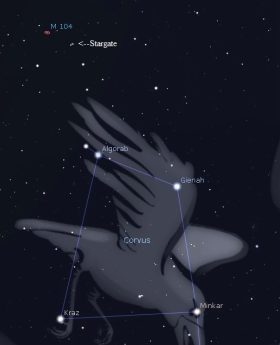This Week’s Sky at a Glance, 2025 Apr 19 – Apr 26
This Week’s Sky at a Glance, 2025 Apr 19 – Apr 26
A favourite galaxy among stargazers is M104, better known as the Sombrero Galaxy. It resembles such a bonnet in astrophotos thanks to a central dust cloud that forms the brim. The dust cloud can be seen from a rural location with a medium-size amateur telescope. The galaxy is seen as a small gray smudge with binoculars.
Although M104 is officially within the borders of the constellation Virgo, most people start their search from the recognizable quadrilateral of stars that forms Corvus the Crow. In mythology, Corvus was sent by Apollo to fetch a cup of water from the river but the bird was distracted by ripening figs. When the crow returned late it made up a tale that it had been deterred by a snake (Hydra). In a fit of rage, Apollo tossed the bird, the cup and the snake into the sky. To the right of Corvus is the constellation Crater the Cup, and they both sit atop Hydra. They can be seen in the southern sky when twilight fades to darkness.
To find M104, imagine a line from the middle of the bottom of Corvus to the upper left star, and extend it not quite that distance. Look in this area for a small arrowhead of three or four stars. This asterism has been called the Stargate. The arrowhead points to a small line of a few stars, which in turn points toward M104 nearby. That line of stars also forms the mouth of an asterism called the Shark, which has a fin and a curved body stretching away from the Stargate. Good luck and wear your Sombrero proudly.
This Week in the Solar System
Saturday’s sunrise is at 6:31 and sunset will occur at 8:15, giving 13 hours, 44 minutes of daylight. Next Saturday the Sun will rise at 6:20 and set at 8:24, giving 14 hours, 4 minutes of daylight.
The Moon is at third quarter this Sunday and to the right of Venus on Thursday. Around 6 am Friday it makes the bottom left corner of a tight triangle with Venus and Saturn, and Mercury is to its lower left. With the shallow angle of the morning ecliptic and the Moon’s position below it, the Moon is at nearly the same altitude for the same time over the week. Mercury is at greatest elongation from the Sun on Monday, but it and especially Saturn will be difficult to get with binoculars in bright twilight. Jupiter sets shortly after midnight this week, followed by Mars three hours later. Early risers might see a few meteors from the Lyrid shower emanating from high overhead on Tuesday.
Tune in to the Sunday Night Astronomy Show at 8 pm on the YouTube channel and Facebook page of Astronomy by the Bay.

